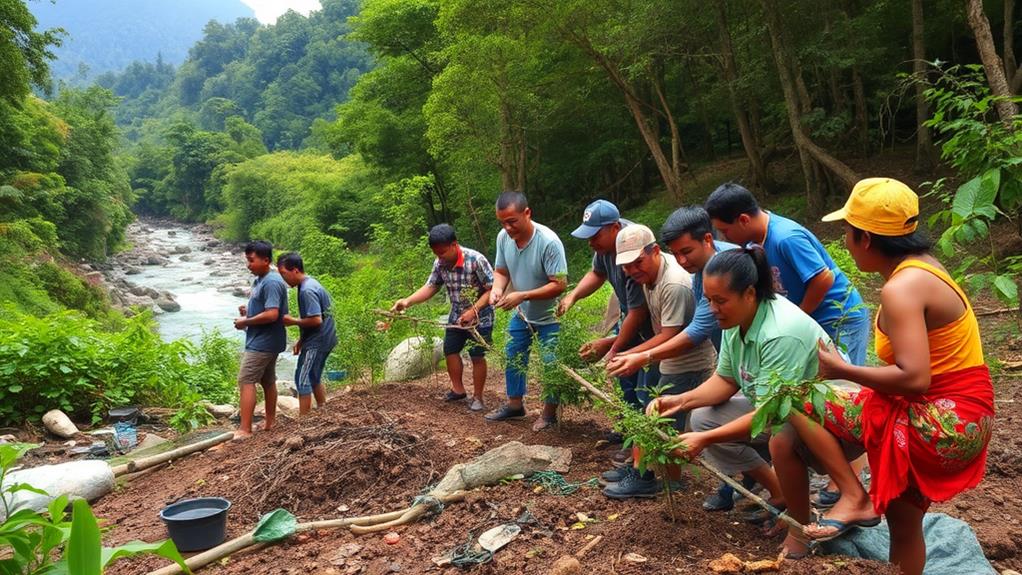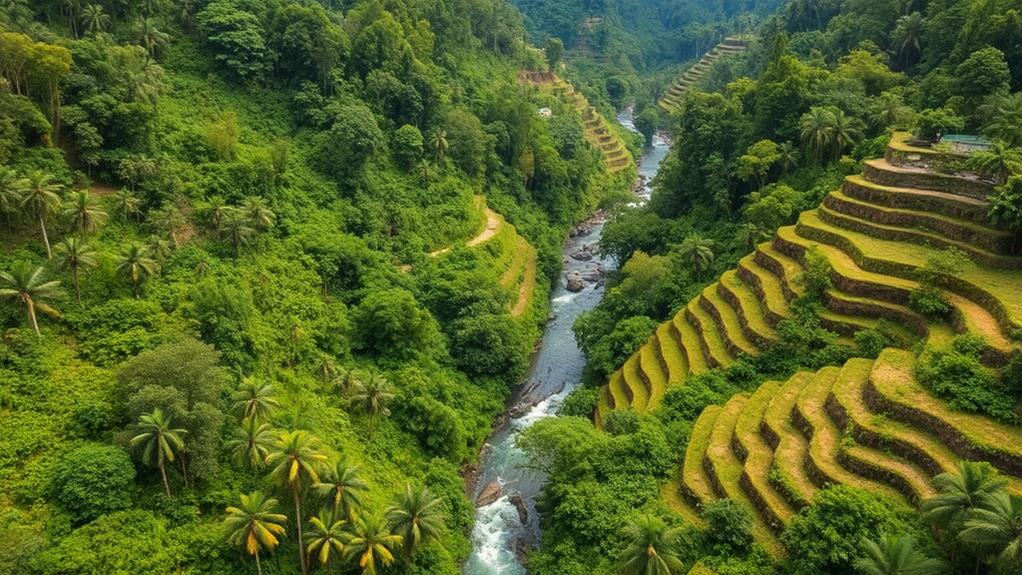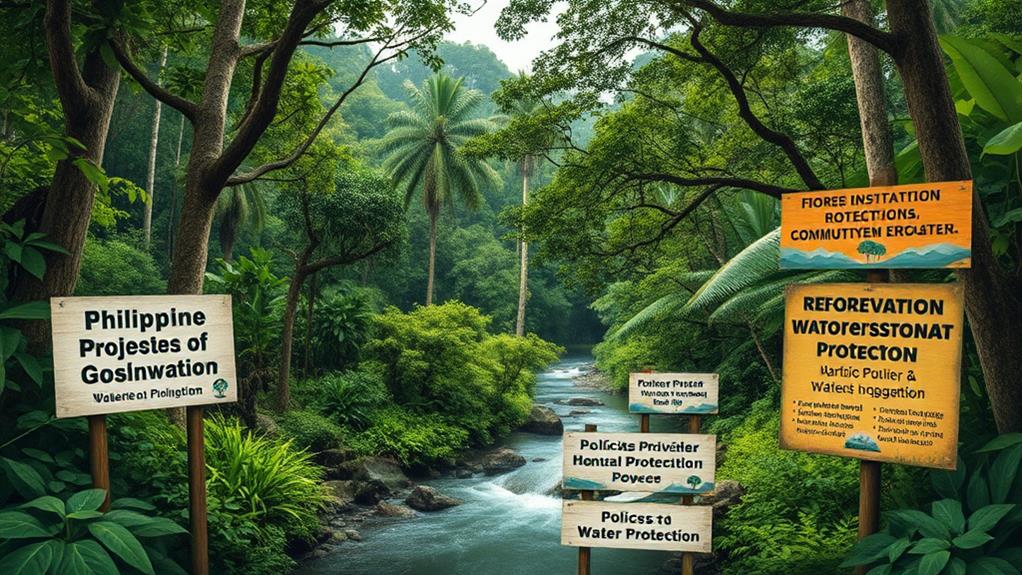Forest conservation is essential for effective watershed management in the Philippines. Healthy forests help prevent soil erosion and keep water clean. This is important for both irrigation and drinking water. The country has 1.35 million hectares of forest that play a key role in maintaining water stability.
However, there are challenges to these forests. Issues like forest degradation and urban development can harm these vital resources. To combat this, community involvement is important. When local people participate in conservation efforts and learn about how watersheds work, conservation outcomes improve.
One effective strategy is reforestation, which involves planting trees in areas where forests have been destroyed. This practice can help restore degraded land.
Understanding the relationship between forests and water is crucial for sustainable development. By engaging communities in protecting watersheds, we can ensure that both people and nature thrive together.
Importance of Forest Conservation

Forests are essential for keeping watersheds stable, which is important for the environment. In the Philippines, forests, especially in the Cordillera Region, cover around 1.35 million hectares and make up 73% of the land. They're crucial watersheds that provide water for local communities.
Forest conservation is key to protecting these ecosystems because it helps prevent soil erosion and keeps water clean.
Forests also help fight against climate change by reducing the effects of extreme weather. When forests are damaged by fires or landslides, it can lead to more flooding and a decreased water supply, which affects the ability of communities to cope with these challenges.
To use forest resources sustainably, it's important for communities to be involved in conservation efforts. Local knowledge can improve watershed management, making restoration efforts more effective.
Overview of Watershed Management
Effective watershed management is essential for keeping water resources balanced. It focuses on managing watersheds in a sustainable way to protect both the quality and quantity of water. For example, in the Philippines, watersheds are important for providing irrigation for farming, drinking water for communities, and hydroelectric power for energy.
Healthy forests play a key role in maintaining watershed health. They help keep these areas ecologically strong. However, many community programs that aim to protect watersheds aren't very effective. As a result, local people often have only a basic understanding of how these ecosystems function.
Good watershed management not only conserves resources but also boosts biodiversity and soil health, and helps to reduce the effects of climate change.
Regular monitoring and evaluation of watershed management practices are necessary for success. Being able to adapt to environmental changes is crucial for the long-term health of water resources.
It is important for communities to be involved and to recognize how their natural resources and forest management are connected.
Role of Community-Based Programs

Community-based programs are essential for raising awareness and taking action to protect watersheds. In the Philippines, community-based forest management initiatives have increased local awareness of these important ecosystems by 33.2%. This participation is crucial because many people living in upland areas have only completed primary education.
By joining these programs, you can greatly enhance your understanding of how watersheds work and the importance of protecting them. Strengthening these community-based initiatives can make watershed protection strategies more effective.
When you actively help manage forest resources, you support the health of watersheds. A study conducted in five upland communities showed that awareness of watershed protection practices is vital, which means that education should be a top priority.
Your involvement not only helps the environment but also promotes sustainable use of resources. By collaborating within community-based programs, you can ensure local practices align with larger conservation goals, which leads to healthier ecosystems.
Ultimately, these programs empower you and your community to take charge of local forest resources, creating real change in watershed management across the Philippines.
Challenges to Forest Conservation
Despite community-based programs helping raise awareness about watershed management, forest conservation in the Philippines faces serious challenges. Here are some key issues:
- Forest Degradation: From 2000 to 2005, the Philippines lost 2.1% of its forest cover each year. This loss mainly comes from overuse of forest resources and converting land for farming and cities.
- Fire Vulnerability: Around 116,000 hectares in the Cordillera Region are at risk of fires. Climate change and higher temperatures make this problem worse.
- Landslide Risks: Almost 73% of the forests in the region are vulnerable to landslides. Between 2007 and 2018, there were 182 recorded landslide incidents, which threaten both nature and local communities.
- Urban Pressures: Rapid growth in cities and population leads to more strain on forest resources. This urban expansion contributes to further forest damage.
These issues are intensified by climate change, which may cause higher temperatures and less rainfall, putting forests at risk.
As these problems connect, they make conservation efforts more challenging.
Addressing these issues is essential for protecting forests and watersheds in the Philippines.
Innovative Management Approaches

Innovative management approaches are changing how we protect forests and watersheds in the Philippines. The Forest and Landscape Restoration strategy, adopted by the government and the FAO, aims to improve these important areas.
One effective method is Assisted Natural Regeneration, which helps degraded forests to recover naturally. This recovery is essential for keeping watersheds stable.
Using nature-based solutions like reforestation and agroforestry can tackle environmental problems while enhancing watershed health. For example, reforestation, which involves planting trees in deforested areas, can restore ecosystems and improve water quality.
Soil conservation and erosion control practices are also key parts of these management strategies. They help prevent soil loss, making sure that watersheds stay strong and productive.
Engaging local communities and stakeholders in decision-making is vital for success. When community members participate, they feel a sense of ownership, leading to better outcomes in forest conservation and watershed management.
These innovative strategies not only improve forest conditions but also protect essential water resources for future generations.
Community Engagement Strategies
Effective community engagement is essential for managing watersheds in the Philippines. Involving local communities can improve conservation efforts and promote sustainable practices. Here are four important strategies:
- Local Ownership: Encourage community-led initiatives to empower residents in revitalizing their watersheds. For example, local groups can organize clean-up drives or reforestation projects.
- Capacity Building: Provide training programs that teach community members sustainable land use practices. Workshops can focus on organic farming techniques or water conservation methods.
- Collaborative Partnerships: Collaborate with local stakeholders, such as indigenous groups and NGOs, to ensure conservation efforts meet community needs. Joint projects can address specific environmental challenges faced by the community.
- Education and Awareness: Increase understanding of watershed protection through educational activities. Schools can hold seminars or field trips to teach students about the importance of preserving water sources.
Economic Benefits of Conservation

Understanding the economic benefits of forest conservation can increase community support for watershed management. When people see how conservation helps their income, they are more likely to practice sustainability. For example, forest conservation boosts ecotourism, which brings in money for local businesses. It also provides forest products like timber and non-wood items, creating income for families.
| Economic Benefits | Description | Impact on Communities |
|---|---|---|
| Ecotourism | Sustainable visitor experiences | Increased income from tourism |
| Forest Products | Timber and non-wood product sales | Generates income for local families |
| Improved Agriculture | Enhanced crop yields and food security | Better nutrition and food availability |
| Cost Savings | Reduced drinking water treatment and infrastructure | Economic savings for local governments |
Restoring watersheds can lead to improved agricultural productivity, which means more food and better nutrition for communities. Local governments benefit too, as they spend less on water treatment. Community-led projects can provide new job opportunities, connecting conservation with economic growth. By recognizing these economic benefits, individuals can actively support practices that are good for both the environment and their community's future.
Monitoring and Evaluation Practices
Monitoring and evaluation practices are essential for successful watershed management, particularly after recognizing the economic advantages of conserving forests. Here are the main points:
- Tracking Forest Cover: Regular monitoring allows for the assessment of changes in forest areas. For example, in the Philippines, there was a significant 2.1% annual loss of forest cover from 2000 to 2005.
- Data-Driven Decisions: Analyzing data from monitoring helps in adapting management strategies. This is important for keeping conservation efforts effective against threats like forest fires and landslides.
- Critical Indicators: Metrics such as water quality, biodiversity levels, and soil stability are crucial indicators for evaluating watershed health. For instance, measuring these indicators can help determine the overall condition of the watershed.
- Community Engagement: Evaluating community-based forest management programs helps identify gaps in awareness and participation. This leads to better education and engagement strategies, ensuring that more people are involved in conservation efforts.
How Does Forest Conservation Contribute to Protecting Watersheds and Water Resources in the Philippines?
Forest conservation plays a crucial role in protecting philippines water resources. By preserving the natural cover of forests, it helps to prevent erosion and sediment runoff into watersheds. This in turn maintains the water quality and quantity, ensuring a sustainable supply for various uses, including agriculture and human consumption.
Policies Supporting Watershed Protection

Effective policies can greatly improve watershed protection. In the Philippines, the National Integrated Protected Areas System (NIPAS) Law designates protected areas and buffer zones. This law helps keep important natural areas safe from harm.
The Philippine Environmental Impact Assessment (EIA) System also supports watershed protection by requiring environmental assessments for projects that might affect watersheds. This promotes sustainable practices that care for the environment.
Community-based forest management policies encourage local people to take part in conservation. When locals are involved, they manage forest resources better and use them in a sustainable way, which helps protect watersheds.
The Master Plan for Forestry Development includes plans for reforestation and protecting existing natural forests, which are essential for stable watersheds.
The Department of Environment and Natural Resources (DENR) works with different groups to enforce these policies. This collaboration ensures that forest conservation efforts align with watershed management goals.
Future Directions for Conservation
The future of forest conservation in the Philippines depends on strengthening community-based initiatives that involve local people in managing watersheds.
Here are some important actions to take:
- Education Programs: Start education and training programs to teach people about how natural watersheds work and their importance. For example, workshops can show farmers how healthy watersheds improve crop yields.
- National Forestation Programme: Aim to reforest 100,000 hectares each year to help restore ecosystems and increase biodiversity. This means planting trees in areas that have lost forest cover.
- Collaborative Approaches: Work with local stakeholders, including indigenous groups and government agencies, to create effective conservation plans. For instance, involving local fishermen can help protect fish habitats.
- Monitoring and Evaluation: Set up regular assessment tools to check the success of watershed management efforts. This helps ensure that strategies remain effective over time.
Questions and Answers
What Is the Importance of Forest Management in the Philippines?
Forest management is essential in the Philippines. It promotes sustainable practices, which means using resources in a way that does not harm the environment. For example, replanting trees after logging helps maintain forest cover.
Additionally, forest management protects biodiversity. This means it helps preserve different species of plants and animals. For instance, creating protected areas allows endangered species to thrive without human interference.
Furthermore, effective forest management fosters community engagement. This means local people are involved in decision-making. Programs that teach communities about sustainable harvesting of forest products create jobs and improve local economies.
How Do Forests Help Watersheds?
Forests enhance watersheds by promoting biodiversity and improving water quality. They absorb excess rainfall, which helps prevent flooding. For example, when it rains, trees and plants capture water, allowing it to soak into the ground instead of running off into streams. Forests also stabilize soil, which reduces erosion. This means that the soil is held in place by tree roots, preventing it from washing away during heavy rains. Additionally, forests support diverse ecosystems. This biodiversity contributes to the overall health of the watershed, as different species interact and thrive together. In summary, forests play a crucial role in maintaining the health of watersheds by absorbing water, stabilizing soil, and supporting a variety of life.
What Is the Forest Conservation Act in the Philippines?
The Forest Conservation Act in the Philippines is a law that aims to protect forests and promote sustainable use of forest resources. It helps create protected areas, which keep wildlife safe and preserve natural habitats. For example, these protected areas can include national parks where endangered species live. Additionally, the Act supports local communities by giving them a role in managing these forests. This involvement helps ensure that people can benefit from the forest while also taking care of it. Overall, the Forest Conservation Act works to maintain a balance between nature and human needs for future generations.
What Is the Forest Protection Program in the Philippines?
The Forest Protection Program in the Philippines aims to protect and restore forests. This program focuses on reforestation efforts, which involve planting new trees in areas where forests have been cut down or damaged. For example, communities work together to plant native tree species, helping to bring back the natural environment.
Additionally, the program encourages community involvement. Local people participate in activities that promote sustainable forest management. For instance, they may help monitor wildlife and report illegal logging. This involvement helps ensure that the forests are cared for and protected.
Another key goal is biodiversity preservation. The program works to maintain a variety of plant and animal species in forest areas. For example, protecting habitats allows different species to thrive, which is important for a balanced ecosystem.